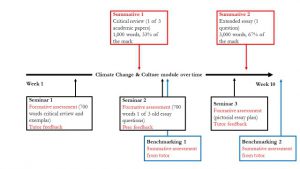This page provides a simple guide to designing assessments into a module/programme, or conducting a review of the assessments. For other examples in use, see the Assessment Mapping page.
At the programme level:
- Gather your programme team together.
- Make a list of the learning aims and outcomes for the programme.
- If this is an existing programme, are these LOs still valid and relevant to the discipline, the institution and department priorities? Do they take into account inclusivity and employability concerns as part of the programme rather than an add-on?
- Is there sufficient progression of levels of learning? Use QAA guides to help.
- Produce a table or grid with the programme aims in the left horizontal column and the module titles in the vertical. This allows you to see in which modules the programme outcomes are being covered.
- Ideally there should be a spread of LOs across the programme, as in the example above, but this is not always the case. Visualising your learning outcomes in this way allows you to revise core and elective modules to alleviate repetition or add in new skills and LOs.See the example below from Georgetown University, USA:
Example 1: BSc in International Health: Goals and Curriculum Matrix Programme Outcomes Core knowledge Critical Thinking Fuse Knowledge and Practice Contribute to the Well-being of all People Experiential Learning/Social Justice Analytical Skills Development of the Research Process Module 140: Intro to International Health X X X 177: Epidemiology X X X X X 441: Community Internship X X X X 444: Global Patterns X X X X X X 445: Globalization and Healthcare X X X 450: International Health Practicum X X X Often the core knowledge is the most ‘covered’ with other skills playing a less significant part. Mapping can allow you to redress the balance.
- Next map your assessments onto your LOs using a different version of the same grid.
Example 1: BSc in International Health: Goals and Curriculum Matrix Programme Outcomes Core knowledge Critical Thinking Fuse Knowledge and Practice Contribute to the Well-being of all People Experiential Learning Social Justice
Analytical Skills Development of the Research process Module Assessment type 140: Intro to International Health 2000 word essay X X 0 177: Epidemiology Exam (Jan) Exam
(June)
X ? 0 ? 0 Note that in the above example, the 2000 word essay meets two of the LOs but staff could not find where it might meet the ability to contribute to the well-being of all people.
The Epidemiology exams were deemed to be ambiguous in the way the questions were written as to whether it was assessing analytic skills as staff agreed it relied mostly on rote learning apart from one short essay which assessed criticality.
- Use a simple timeline to map your formative and summative assessments, the submission deadlines and the return dates for each module. See the examples A and B below:A: a timeline
 B: a simple grid
B: a simple grid
Intro to International Health Epidemiology Community Internship Global Patterns Globalization and Healthcare Sept Oct X X Nov X X X Dec X X Jan X X X Feb March April X May X June X X X X X - Analyse your assessment patterns using the TESTA Assessment Patterns which work and which fail document. This provides a clear guide to evaluating the patterns on your modules and programmes.
- Use the Ensuring the Balance guide and AFL@Kings to help you address any issues you notice
At the module level
- Gather your module team together. All people who teach on the module should be involved so that even colleagues who only deliver one or two lectures can visualise the larger picture.
- The above steps at the programme level are still useful as they will help you to visually identify how your module fits into the larger programme.
- Map your assessments to your LOs using a grid (as above).
- Use a simple timeline or grid (example A or B above) to map your formative and summative assessments, the submission deadlines and the return dates.
- Analyse your assessment patterns using the TESTA Assessment Patterns which ‘work’ and which ‘fail’ . This provides a clear guide to evaluating the patterns on your modules and programmes.
- Use the Ensuring the Balance guide and AFL@Kings to help you address issues.
Two further resources which might help you to analyse Assessment patterns on programmes: Contact King’s Academy for spreadsheets and full materials
